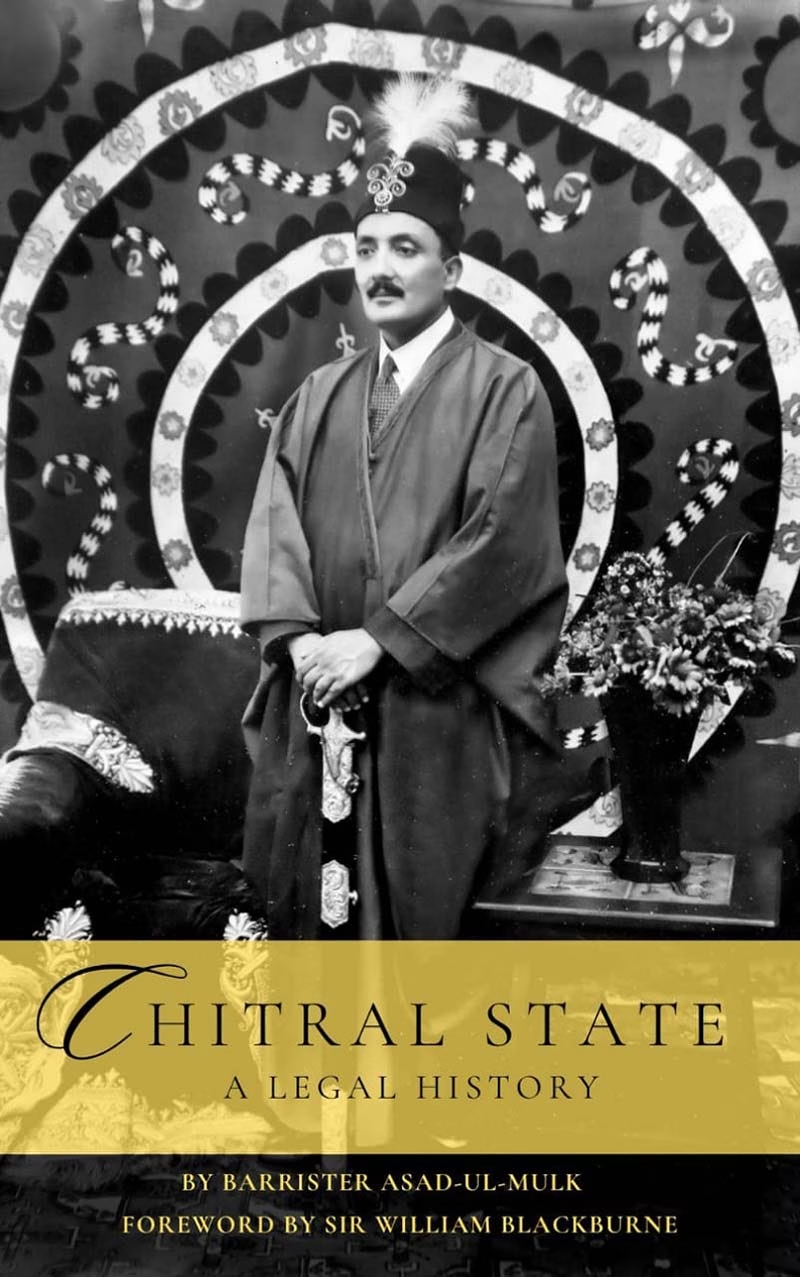A new book titled ‘Chitral State: A Legal History’ by Barrister Asad-ul-Mulk has gone into printing and is scheduled to be launched soon. Most books on Chitral’s history scrutinize bygone eras from historical, political, sociological, cultural or anthropological perspectives. There is hardly a comprehensive book on Chitral which studies the past from a legal perspective.
‘Chitral State: A Legal History’ in unique in this respect as it views history through a legal lens, and subjects it to jurisprudential analysis.
The author of the book, Barrister Asad-ul-Mulk, hails from Chitral and has the distinction of being the first person from Chitral to be called to the Bar of England & Wales. Barrister Mulk received his call from the Lincoln’s Inn which is one of the four Inns of Court based in London. Barrister Mulk is the son of Shahzada Masood-ul-Mulk, the CEO of the Sarhad Rural Support Programme (SRSP). The foreword of the book has been written by eminent English jurist Sir William Blackburne.
‘Chitral State: A Legal History’ attempts to trace the legal history of the territories forming the erstwhile State of Chitral from time immemorial. Building on the pre-state narrative, the book unravels the emergence of the state over the region in the 14th century, and the gradual development of a coercive court mechanism. The nature and facets of the legal hierarchy, and its monarchial character are subjected to scrutiny.
Since the customary laws of the State of Chitral were invariably never codified, a conscious attempt has been made to document the customary laws of the region. The documentation sets out in detail the nature of a wide variety of laws, including; criminal, civil, property, personal, taxation and administrative law.
The customary laws documented also expound upon the reciprocal obligations of the state and the individual. The contents of the customary laws have been gathered from hundreds of distinct and verifiable sources, and elaborated upon. The book explains the operation of law in a feudal and stratified society.
The jurisdiction of the indigenous Courts i.e. the Qazi Courts, the Mizan-e-Shariah, the Judicial Council and the Mehtar’s Court are studied.
The enforcement mechanism through which the judgments of the indigenous Courts were implemented is also inquired into detail with reference to ancient edicts, royal decrees and proclamations. The position of the Mehtar (Ruler) as well as that of other state functionaries (judicial and quasi-judicial), as recognized by the legal system, becomes the subject of lengthy discourse in the book.
The evolution of the legal system, over the centuries, also constitutes the subject matter of the thesis. British influence, following the 19th century, is analyzed and investigated. And as a corollary, the concepts of sovereignty, suzerainty, subsidiary alliance and paramountcy come under jurisprudential discussion.
The book reproduces all the important treaties executed between the State of Chitral and the British Crown. Also replicated are many important letters and correspondence between the Mehtar of Chitral and the Viceroy of India, the Commander-in-Chief, the Secretary of State, the Governor and Chief Commissioner of the North West Frontier Province. Moreover, important correspondence between the Mehtar of Chitral and the Rulers of other princely states and the Quaid-e-Azam also find feature. The vast majority of the documented letters and correspondence reproduced in this book have never been published before, and they illuminate the internal working of the State of Chitral including its legal system.
Events of cataclysmic legal and territorial significance for the State of Chitral such as the severance of Mastuj (including Yarkhun and Kuh) and Laspur on the North-Western side and Ghizar, Yasin and Ishkoman on the northeastern side from the State of Chitral are studied. Similarly, the severance of Narsat, Bashgal and Dokalam on the southern side also come under discussion. The reversion of Mastuj in 1914 and the agreement on which that reversion is founded are deliberated upon. The status of the dependency of Kalam and its relation to the State of Chitral are pondered over, as are the limits of the boundary of the State of Dir. The legal instruments and treaties effecting severance and reversion are reproduced and subjected to jurisprudential scrutiny.
In depth chronology of events surrounding all successions to the Rulership of the State of Chitral since the mid-19th century are provided in the book.
The formation and responsibilities of the Chitral State Bodyguard Force and the Chitral Scouts is traced and analyzed. The relationship of the State of Chitral with the State of Kashmir and the Emirate of Afghanistan forms the subject of prolonged critique.
Finally, the book proceeds to discuss the legal mechanism under the ‘Indian Independence Act 1947’(an Act of Westminster Parliament) that brought about the lapse of paramountcy, and eventually resulted in the accession of the State of Chitral to the Dominion of Pakistan in 1948. The book reproduces and discusses the constitutional significance of a plethora of documents including the Instrument of Accession of the State of Chitral.
The book spreads over 530 pages and will shortly be available with Vanguard Books and other retailers.

